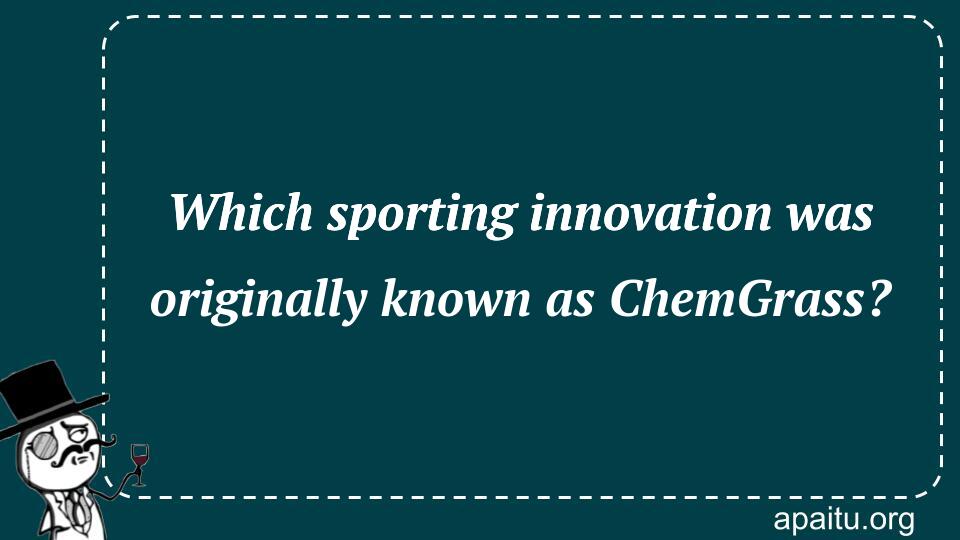Question
Here is the question : WHICH SPORTING INNOVATION WAS ORIGINALLY KNOWN AS CHEMGRASS?
Option
Here is the option for the question :
- Asphalt
- Rebound Ace
- VaporWeave
- AstroTurf
The Answer:
And, the answer for the the question is :
Explanation:
Donald L. Elbert, James M. Faria, and Robert T. Wright invented AstroTurf artificial grass in 1964. It was originally known as ChemGrass, but the name was changed in 1966 after the surface was successfully employed at the Astrodome, home of the Houston Astros. Soon after, AstroTurf began to be employed in numerous sporting arenas, particularly in regions where natural grass was difficult to maintain due to weather conditions. Artificial grass is now popular not only in athletic settings, but also in people’s backyards.

AstroTurf: The Evolution of a Sporting Innovation
In the world of sports, innovation has always played a vital role in enhancing performance, safety, and the overall experience for athletes and fans alike. One such groundbreaking innovation that revolutionized the playing surface of various sports is AstroTurf. Originally known as ChemGrass, AstroTurf has transformed the way we play and perceive sports like football, soccer, baseball, and more. Let’s delve into the history and evolution of AstroTurf, tracing its roots from its early beginnings to its widespread adoption across the sporting world.
AstroTurf, the brainchild of chemist James M. Faria and his colleagues, was initially developed as a solution to the challenges of maintaining natural grass playing surfaces. In the mid-1960s, the demand for durable and weather-resistant surfaces for sports gained prominence, especially in indoor arenas and stadiums. Faria and his team at the Chemstrand Company, a division of the Monsanto chemical corporation, set out to create a synthetic surface that could withstand heavy use and provide consistent playing conditions.
The original name of this synthetic surface was ChemGrass, reflecting its chemical composition and its intended purpose as a grass substitute. However, as the product gained popularity and recognition, it was rebranded as AstroTurf in 1966, a name that would soon become synonymous with synthetic turf.
The early versions of AstroTurf featured short, densely packed nylon fibers that were tufted into a backing material. This construction provided a surface that emulated the look and feel of natural grass while offering increased durability and resistance to wear and tear. The introduction of AstroTurf was met with enthusiasm, as it allowed sports teams and organizations to maintain consistent playing conditions throughout the year, regardless of weather conditions or heavy usage.
One of the significant milestones for AstroTurf came in 1966 when it was installed at the Houston Astrodome, the first domed stadium in the world. The Astrodome’s decision to use AstroTurf paved the way for its widespread adoption in both indoor and outdoor sports facilities. This revolutionary playing surface soon found its way into football stadiums, soccer fields, baseball parks, and various other sporting venues across the globe.
Over the years, AstroTurf underwent continuous development and improvement. New generations of the synthetic turf featured advancements in fiber composition, infill materials, and installation techniques. The goal was to create a playing surface that closely mimicked the performance and safety characteristics of natural grass while offering enhanced durability and consistency.
AstroTurf has become a staple in the world of sports. Its impact is felt across multiple disciplines, from professional sports leagues to recreational facilities. The benefits of AstroTurf are numerous. It provides a reliable and consistent playing surface, reducing the risk of injuries caused by uneven terrain. It also allows for increased playing time, as the surface can withstand heavy use and does not require extensive maintenance like natural grass.
Moreover, AstroTurf has opened up new possibilities for sports. It has enabled the construction of indoor arenas and stadiums in locations where natural grass would be impractical or impossible to maintain. It has expanded the reach of sports, allowing games to be played in regions with extreme climates or limited access to outdoor spaces.
AstroTurf has faced some criticism over the years. Some players and purists argue that the synthetic surface lacks the natural feel and aesthetics of real grass. However, advancements in technology and design have significantly narrowed the gap between AstroTurf and natural grass, providing a playing experience that is increasingly indistinguishable from the real thing.
AstroTurf, originally known as ChemGrass, has transformed the sporting landscape by offering a synthetic alternative to natural grass playing surfaces. Developed to address the challenges of maintaining consistent conditions, AstroTurf has revolutionized sports like football, soccer, and baseball. Its durability, reliability, and ability to withstand heavy use have made it a popular choice for sports facilities worldwide. While it has faced criticism, AstroTurf continues to evolve, bridging the gap between synthetic and natural playing surfaces. As technology advances, it is likely that we will witness further innovations in the realm of sports surfaces, ensuring that athletes can perform at their best while enjoying the benefits of a reliable and high-performing playing field.